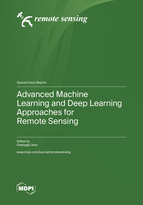Cloud Removal from Satellite Images Using a Deep Learning Model with the Cloud-Matting Method
Round 1
Reviewer 1 Report
This is my initial review on " Cloud Removal from Satellite Images using a Deep Learning Model with the Cloud Matting Method ".
In this manuscript, the authors propose a "a novel method that considers the surface reflection and cloud top reflection as a linear mixture of image elements from the perspective of image superposition".
The subject is important, very interesting, and timely, nevertheless it can not be considered for publication, at least, after major
revision.
I found several editing problems and lack of clarity that complicate the review and even the analysis of results. For example, in Sec. 1, Introduction, Eq. 1 appears with no justification of citation (at least citation). Then, as a separate section, Prior Works, which should be developed in Introduction. Then, in Methodology, there are duplicate paragraphs, as the authors would use copy/paste indiscriminately, with no detailed review....("As shown in Fig. 1...)" , etc. Please, take a time to read what are you sending to publish.
Author Response
Dear reviewer,
Grateful thanks to the reviewer for your thoughtful and helpful review. We have made almost all the changes in our revised manuscript. In view of your comments, we have carefully made some modifications to the manuscript. Major revision has been done in the Introduction, Methodology, Results, and Discussion Section. The Introduction Section is improved, and the relevant references have been added or replaced. Additionally, some typographical errors or wording have been corrected or changed.
The changes which have been made are highlighted in the revised manuscript with blue color.
Please see the attachment.
Best regards,
Deying Ma
Author Response File: ![]() Author Response.pdf
Author Response.pdf
Reviewer 2 Report
The manuscript presents the findings of a developed deep learning model for cloud occlusion removal wherein a two-step CNN was used for the extraction of transparency information of clouds and the recovery of the surface information of thin cloud regions.
All the sections of the manuscript are well and commendably written.
Meanwhile, the authors have identified some related works but the presented literature is not detailed enough. The authors should highlight the specific major drawbacks of each of the reviewed literature and also highlight how this research will fill the identified gaps. Since cloud occlusion identification and removal from optical remote sensing images is a hot topic, I expect the authors to be more current in their review. At least, more articles published in 2022 should be reviewed and included. Specifically, emphasis should be placed on the review of the other four cloud removal methods that were experimented with in the article.
The authors should also provide further justification for why their model outperformed other models, especially the Spatial attentive generative adversarial network (SpAGAN) which is said to out-perform the CNN autoencoder (https://doi.org/10.1016/j.rsase.2022.100700; https://doi.org/10.1109/TGRS.2021.3093977; https://doi.org/10.48550/arXiv.2009.13015; https://doi.org/10.3390/rs14143452).
Finally, the authors should also check the listed references viz-a-viz the in-text citations and ensure that all listed references are duly cited in the manuscript and vice versa.
Author Response
Dear reviewer,
Grateful thanks to the reviewer for your thoughtful and helpful review. We have made almost all the changes in our revised manuscript. In view of your comments, we have carefully made some modifications to the manuscript. Major revision has been done in the Introduction, Methodology, Results, and Discussion Section. The Introduction Section is improved, and the relevant references have been added or replaced. Additionally, some typographical errors or wording have been corrected or changed.
The changes which have been made are highlighted in the revised manuscript with blue color.
Please see the attachment.
Best regards,
Deying Ma
Author Response File: ![]() Author Response.pdf
Author Response.pdf
Reviewer 3 Report
The authors proposesd a cloud removel algorithm for remote sensing images using cloud matting, which has certain novelty. But when the method is introduced in the third part, the energy intensity received by the satellite (Equation 2) is wrong, the reflection intensity at the top of the cloud is Ecloud, why multiply it with the opacity α of the cloud? If there is a problem with the principles and methods used, the subsequent analysis is completely inaccurate.
Please to carefully verify the principles used in this article and to make corrections.
Author Response
Grateful thanks to the reviewer for your thoughtful and helpful review. We have made almost all the changes in our revised manuscript. In view of your comments, we have carefully made some modifications to the manuscript.
Please see the attachment.
Author Response File: ![]() Author Response.pdf
Author Response.pdf
Round 2
Reviewer 3 Report
Thanks to the authors for the serious reply.
The authors' reply can basically answer my question, please add a detailed description of the meaning of Equation 2 in the revised article.
At the same time, please correct the identification on the figure, in general, reflectance represents the ratio of reflected radiation to incident radiation, which is inconsistent with the text expression.
Author Response
Please see the attachment.
Author Response File: ![]() Author Response.pdf
Author Response.pdf





